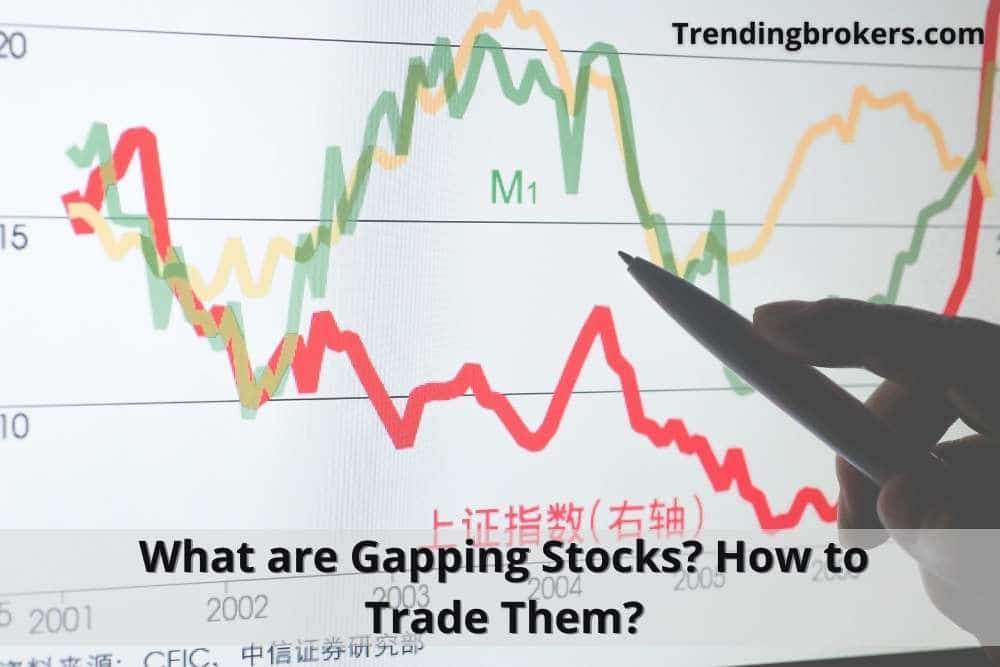Gapping stocks refer to the stocks that open up above or below the previous day’s closing price. Gap trading is a popular trading style to long or short the stock. The technique is appreciated by many traders worldwide for its multiple benefits. But why does gapping occur? How is it beneficial for traders? We will answer these questions in detail in this article.
It is also a phenomenon that can be helpful for technical analysis and fundamental analysis in stock trading. When there is low market liquidity, there are higher chances of a gap occurring as there are not enough buyers and sellers. Gaps can also happen in high trading volume markets like foreign exchange.
What are Gapping stocks?
A gap is different in price levels between two consecutive days i.e close and open. When the price of a stock or other asset opens up either above or below the previous day’s closing with no trading activity in between, that is known as gapping.
Thus, although those classifications are valuable for a longer-term knowledge of how a company or sector reacts, they don’t provide much in the way of trading advice. A gap is a price discontinuity in the price chart of security. That is, the difference between one form of gap and another may only be discerned after the stock has continued to rise or fall in some way.
The dynamic gap is a metric that tracks how assets and liabilities fluctuate over time. The difference or spread in rates at which banks borrow and lend is also known as gapping. Moreover, despite the fact that most technical analysis manuals designate the four types of gap patterns as Common, Breakaway, Filled, Continuation, and Exhaustion, such labels are applied after the chart pattern has been constructed.
A gap exists when a security’s opening price is either much higher or lower than its previous closing price, with no further trading activity in between. Gaps can also form when headlines cause market fundamentals to shift fast during hours when markets are normally closed, for example- after an earnings call.
Full Gaps
Breakaway, runaway, and exhaustion gaps are full gaps, whereas common gaps are partial gaps. In addition, short signals can be utilised as exit signals to sell assets. Therefore understanding the mechanics of gaps is vital for long-term investors.
In the case of short situations, a trailing stop is simply an exit threshold that follows the rising or dropping price. To trade gapping stocks successfully, one must apply a disciplined set of entry and exit criteria to indicate trades and reduce risk.
The long and short trading signals define the eight gap trading techniques for each of the four gap kinds. When the open is entirely beyond the previous day’s price range, it is called a full gap. The main premise of gap trading is to give the stock price an hour to establish its range when the market starts.
For traders, each sort of gap sends out different indications. A modified trading method can be employed with any of the eight major techniques to initiate trades before the first hour, but it comes with a higher risk.
You calculate and set a trailing stop to quit a long position and a trailing stop to exit a short position once you’ve established a position. Because specific gaps are usually modest and occur on a regular basis, they don’t supply much in the way of analytical information. Gap trading tactics can also be used to trade weekly, end-of-day, or intraday gaps.
Partial Gaps
The danger and potential advantage are the differences between a Full and Partial Gap. In general, when a stock gaps entirely over the previous day’s high, the market’s inclination to acquire or sell it changes dramatically.
In general, total gapping stocks have a better chance of gaining over several days. After the initial orders are placed, if there is not enough interest in selling or purchasing a stock, the stock will swiftly return to its trading range. Because of the high demand, the market maker or floor specialist is forced to offer a significant price modification to fulfill the unfilled orders.
Those with a full gap tend to trend in one way more than stocks with a partial gap. However, if there is less demand, the trading floor may just need to move prices above or below the previous close to prompt buying or selling to fill on-hand orders. Entering a trade for partially gapping stocks usually necessitates more attention or closer trailing stops.
Gap-up stocks
On a price chart, gap-up stocks are relatively straightforward to see. Blank spaces between candlesticks indicate market gaps, and gap-up stocks are followed by a green candlestick on the open. This suggests a price rally, which might indicate the start of a new trend or be an outlier. A wide void in the price chart is followed by a green candle, indicating that the asset’s price has risen due to an external event.
The term gap-up refers to when the price of a financial instrument opens higher than the previous day’s price. For example, in the stock market, a partial gap-up happens when the opening prices rise, but the price does not exceed the prior high price.
Gaps and gap downs are always calculated using the price levels of two consecutive days. Therefore, full gap ups and full gap downs are crucial from a decision-making standpoint. Because of the high demand, the market maker or floor specialist is forced to offer a significant price modification to fulfill the unfilled orders.
When the next day’s beginning price is higher than the previous day’s high price, this is known as a full gap up. The gap-up point is depicted by the green arrow.
Gap-down stocks
Gap down stocks have the same structure as gap up stocks but in the other direction. The whole gap up is indicated by the green arrow in the chart below, while the full gap down is presented by the red arrow. Despite the fact that the stock begins in an uptrend, market gapping quickly reverses the stock into a downturn.
The Gap-down occurs during when the price of a financial instrument opens up lower than the previous trading day. When there is a shift in investor sentiment, a gap-down occurs. In the stock market, a partial gap down happens when the opening price is lower than the previous day’s closing price but also, not lower than the last day’s low price
It is called a full gap-down when the stock’s opening price is less than the previous day’s low price. A red candlestick appears after the blank gap in the market, indicating a bearish price decrease outside of support and resistance levels.
A partial gap-up happens when the opening price is higher than the previous day’s closing but not higher than the previous day’s high. On the gap-down front, it occurs when today’s price is lower than yesterday’s closing price but not lower than yesterday’s low.
Types of Gaps
- Common gap: These are the most prevalent market gaps. However, they can also happen during the trading day, especially if there is a lot of buying or selling pressure. They typically occur as a new trading day begins in the stock market or after the weekend trading hiatus in the Forex market.
- Continuation gap: Continuation gaps appear in the middle of powerful uptrends or downtrends, and they are always in the same direction as the underlying trend. They indicate whether there is strong purchasing pressure in uptrends or intense selling pressure in downtrends.
- Filled gap: Markets frequently fill the gap between the closing and opening prices after a gap emerges. This is especially true for common gaps, which can be exploited to create a trading method.
- Breakaway gap: A breakaway gap appears at the top of uptrends and the bottom of downtrends, indicating a possible trend reversal. They can also emerge after large chart pattern breakouts, and they can be exacerbated by excessive trading volume.
- Exhaustion gap: Exhaustion gaps arise in the opposite direction of the underlying trend during powerful uptrends or downtrends. They indicate that the trend is losing steam and that a possible reversal is on the way.
Gapping Stocks trading strategy
In a downtrend, a gap-up stock enjoying a price rally presents a favorable opportunity to sell the stock short. Conversely, in an uptrend, a stock with a gap up offers a favorable opportunity to buy and keep an extended position. Conversely, in a downturn, a stock with a gap down offers a solid opportunity to short sell.
When it comes to gap trading, there are a few things that traders should keep in mind. Gap Trading Strategies are a well-defined trading method that enters and exits using precise criteria. In an uptrend, a gap-down stock with a price fall presents a favorable opportunity to buy.
Traders can utilise gap trading rules to build a trading strategy when spot buying and selling opportunities. Of course, traders should be aware of the fact that not every gap represents the same opportunity, but we can use market action to create forecasts about low-risk, high-reward trades.
There are numerous strategies for profiting from stock market gaps. When technical or fundamental considerations, such as the company’s financial report, justify a gap on opening day, some traders will buy. Paper trading is the simplest approach for testing your own ability to trade gaps properly.
Because the market frequently fills gaps immediately after they develop, common gaps should be traded in the opposite way. One signal is a gap greater than the previous day’s range. It is a gap that is larger than the current trading range, especially in a pennant or flag formation or a well-established resistance or support level.
Traders can attempt to enter in the direction of the trend after a continuation gap emerges since it signals a healthy and robust underlying trend. Traders might develop a trading strategy based on the type of gaps that have occurred and try to profit from them. Knowing how to trade a gap up or down effectively can lead to successful trading chances.
There is no real money involved in the paper trading. Trailing stops are used to safeguard profits and limit losses. Instead, they record or write down the entry signal, then repeat for a leave signal. And finally, to determine a possible profit or loss, deduct the commissions and slippage.
Bottom Line
Gapping stocks that are more volatile and hence have more significant price changes are the most effective to trade in the stock market. When the price of a stock opens up, either above or below the previous day’s closing with no trading activity in between, that is known as gapping. A Gapping is the confirmation of a shift in the sentiment or the beginning or the end of a major market trend. As a result, you should always think about the industry in which one want’s to deal with.
Oil and gas, pharmaceutical, and retail stocks, for example, are believed to be highly volatile to trade, particularly in the face of severe economic conditions or a national recession. You can trade gapping stocks in a comfortable trading environment with an award-winning broker Capixal.


